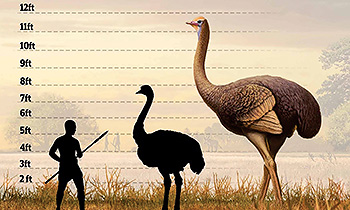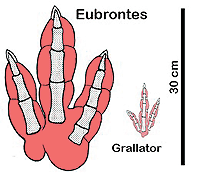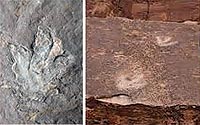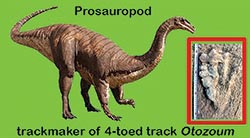 Dinosaur Tracking began in new England in 1802, before the first dinosaurs were named in 1824, and before the term “Dinosaurs” was first used in 1841. Since dinosaurs were not named it was assumed that the tracks, mostly three toed, were made by birds. Many were referred to as Noah’s Raven tracks, and actually raven-sized, but others were huge up to 30 cm (1 foot) or more in length. At the time the giant New Zealand Moa up to 12 feet high had just been discovered. So, the tracks were scientifically named in 1836 as Ornithoichnites (meaning bird tracks). The age of the tracks was not precisely known, until later when they were recognized as Early Jurassic (about 200-175 million years), and the New Zealand Moa was shown to be only a few hundred to a few thousand years old. Today we know that birds are descended from Mesozoic theropods. The New England theropod tracks became world famous and were found in other parts of the world, and the large 3-toed track known as Eubrontes (meaning true thunder) has since become the state fossil of both Connecticut and Massachusetts. Popular scientific consensus attributes Eubrontes tracks to the carnivore Dilophosaurus featured in the movie Jurassic Park. Dinosaur Tracking began in new England in 1802, before the first dinosaurs were named in 1824, and before the term “Dinosaurs” was first used in 1841. Since dinosaurs were not named it was assumed that the tracks, mostly three toed, were made by birds. Many were referred to as Noah’s Raven tracks, and actually raven-sized, but others were huge up to 30 cm (1 foot) or more in length. At the time the giant New Zealand Moa up to 12 feet high had just been discovered. So, the tracks were scientifically named in 1836 as Ornithoichnites (meaning bird tracks). The age of the tracks was not precisely known, until later when they were recognized as Early Jurassic (about 200-175 million years), and the New Zealand Moa was shown to be only a few hundred to a few thousand years old. Today we know that birds are descended from Mesozoic theropods. The New England theropod tracks became world famous and were found in other parts of the world, and the large 3-toed track known as Eubrontes (meaning true thunder) has since become the state fossil of both Connecticut and Massachusetts. Popular scientific consensus attributes Eubrontes tracks to the carnivore Dilophosaurus featured in the movie Jurassic Park.
 Almost a century and a half passed before similar tracks were reported, in the 1970s, from the western USA. These come from what is known as the Glen Canyon Group, named for the Jurassic Formations (Wingate, Kayenta and Navajo) found along the Colorado River at the Glen Canyon National Recreation Area (GLCA) known to many as Lake Powell. A recent survey suggests that we now know of more than 150 sites with Eubrontes tracks, mostly in Utah. This is in addition to at least as many additional Early Jurassic sites with other tracks. The most common of these is the raven-sized track known as Grallator which refers to a bird group known as the Grallae which include heron like wading birds. There are dozens of Eubrontes and Grallator tracksites in the Moab area. Almost a century and a half passed before similar tracks were reported, in the 1970s, from the western USA. These come from what is known as the Glen Canyon Group, named for the Jurassic Formations (Wingate, Kayenta and Navajo) found along the Colorado River at the Glen Canyon National Recreation Area (GLCA) known to many as Lake Powell. A recent survey suggests that we now know of more than 150 sites with Eubrontes tracks, mostly in Utah. This is in addition to at least as many additional Early Jurassic sites with other tracks. The most common of these is the raven-sized track known as Grallator which refers to a bird group known as the Grallae which include heron like wading birds. There are dozens of Eubrontes and Grallator tracksites in the Moab area.
 The most accessible of these sites is the Poison Spider trailhead site. Here you can climb up and touch both track types on at least two large surfaces from different levels in the Navajo Formation. Both Grallator and Eubrontes tracks represent theropod dinosaurs which were the dominant type in the Early Jurassic. This raises interesting questions as to “why so many carnivores?” “what did they feed on?” Some suggest they left so many footprints because they were far more active than other dinosaur types. The most accessible of these sites is the Poison Spider trailhead site. Here you can climb up and touch both track types on at least two large surfaces from different levels in the Navajo Formation. Both Grallator and Eubrontes tracks represent theropod dinosaurs which were the dominant type in the Early Jurassic. This raises interesting questions as to “why so many carnivores?” “what did they feed on?” Some suggest they left so many footprints because they were far more active than other dinosaur types.
However, there are other dinosaur types represented by Early Jurassic tracks in the Moab area. The most distinctive of  these is known as Otozoum (meaning Giant animal) whose tracks can be seen in the Sand Flats area just below the big “G”. Unlike, the tracks of three toed carnivores, Otozoum tracks have four toes and even occasionally front footprints which show they could walk either on two or four feet. The trackmakers of Otozoum are generally considered to be the dinosaurs known as “prosauropods” which are ancestors or forerunners of the true vegetarian sauropods such as Diplodocus and Brachiosaurus that were dominant in the Late Jurassic. I have one paleontological colleague who calls prosauropods “theropod food.” This is another way of saying that tracks tell us something of Early Jurassic paleo-ecology, and that prosauropods had to be on the lookout for their dangerous carnivorous cousins. these is known as Otozoum (meaning Giant animal) whose tracks can be seen in the Sand Flats area just below the big “G”. Unlike, the tracks of three toed carnivores, Otozoum tracks have four toes and even occasionally front footprints which show they could walk either on two or four feet. The trackmakers of Otozoum are generally considered to be the dinosaurs known as “prosauropods” which are ancestors or forerunners of the true vegetarian sauropods such as Diplodocus and Brachiosaurus that were dominant in the Late Jurassic. I have one paleontological colleague who calls prosauropods “theropod food.” This is another way of saying that tracks tell us something of Early Jurassic paleo-ecology, and that prosauropods had to be on the lookout for their dangerous carnivorous cousins.
|